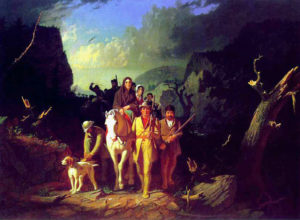On March 10, in a research and pilot project, Curtis Penix will begin an historic 200-mile trek, hiking the path marked by Daniel Boone almost 250 years ago. A 46-year old Michigan native with Kentucky roots, Penix will begin his 16-day trek at Long Island on the Holston River in what is now Kingsport, Tennessee, the site from which Daniel Boone and his party left in March 1775.
Following ancient Indian and buffalo trails, Boone and his party of ax-wielding men blazed a pathway through the wilderness from Tennessee through the Cumberland Gap into central Kentucky. This pathway not only gave tens of thousands of European settlers a way into land in what would become the present day Commonwealth of Kentucky but, also, opened the gateway to the settlement of the west.
Penix will follow in the footsteps of his 5X great grandfather Joshua Penix, who helped establish Boonesborough as a permanent settlement in 1779. Although much of Boone’s original road has been lost to natural forces and land development, Penix will follow the route determined by the research of pioneer history author Neal O. Hammon in the late 60’s and, most recently, by John Fox, MD, president of the Friends of Boone Trace, Inc. (an organization dedicated to historical, educational and research activities for the preservation of the Trace and its legacy).
Approximately 20 % of the route will be through privately owned land which Curtis has been granted permission to cross. “John Fox has done a great job seeking out portions of the Trace that cross private property. He has gained permission from many land owners, and I will do so as well, when possible. I am committed to not knowingly trespass and will skirt any private land where permission has not been received,” explained Penix.
Hiking alone for the first 90 miles, Penix, an experienced backpacker, plans to challenge himself by carrying “the absolute minimum” food and supplies and, like his ancestor, experience the wonders of nature. “Many changes have taken place in the 200 years since the Trace was blazed. For instance, when I ford the Cumberland River in Pineville I will be fighting my way through the choking vines of Kudzu, which was introduced to America 100 years after the Trace was established. But my plans to hike the Boone Trace are rooted in my desire to experience what grandpa Joshua and the other pioneers experienced. They were real people with desires, motivations and hardships that went far beyond mere recreational hiking. This will be a challenge for me, but I want to walk in the shadow of the mountains where Joshua walked, to wade the cold streams that Joshua waded, and sleep under the sky that Joshua slept under.”
At Martin’s Station, VA, Penix will be joined by Givan Fox, son of John Fox, MD. Together, they will complete the remaining 105 miles over Cumberland Gap to Fort Boonesborough, where they plan to arrive on March 26.
Unlike his ancestor, Penix will be equipped with GPS and cellular satellite communications from which he will report his progress. On his website http://www.lostinthewander.com/ followers can track his progress on a map and receive photos and daily blogs on Facebook, e-mail or Twitter. Also he will send prepared posts on each historic site along the way. For example, on the day he arrives at Twettys Fort followers can access a post describing the historical significance of that site.
This project is being planned not only to promote the hike and the trail itself but also to stimulate tourism for the historical sites and communities along the route. Some have hiked portions of the Trace; others have walked farther and longer. Of the few thousand Appalachian Trail hikers each year, more than 300 complete the 2,180-miles route. In light of this feat, the Trace’s 200-mile route might seem insignificant. However, as Penix explained, “The Appalachian Trail or other recreation trails do not have the history or the weight of accomplishment of Boone Trace. The Trace was traveled by warriors who fought for the land that sustained them, pioneers who searched for independence and soldiers who helped forge the greatest country in the world.
“It is estimated that 47 million Americans have ancestors who traveled through Cumberland Gap seeking new lives in the west. If the Boone Trace can be reestablished and opened to the public, literally millions of Americans will have the chance to walk in the steps of their ancestors. Trail towns along the way, like Middlesboro, can serve as hosts for people who want to experience life along ‘that little road’ that helped give birth to the American dream. Other national trails like the Appalachian and Pacific Crest were created to provide a sense of recreational adventure. Boone Trace was created by true adventurers. Along the sides of the Boone Trace there were no discarded energy bar wrappers and ‘points of interest’ signs, but the bones of those who gave their lives to travel it.”

